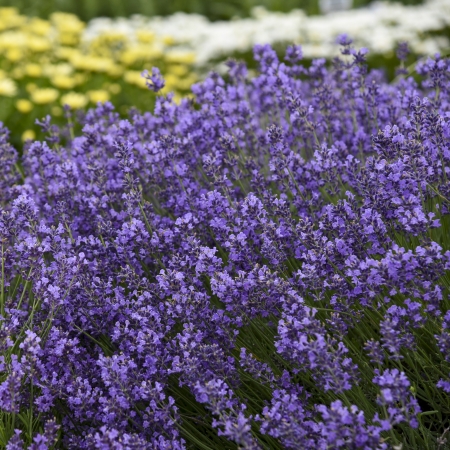Lavandula (Lavender)
×
Color Name: Munstead
Rich lavender flower spikes fill the air with their sweet, intoxicating fragrance all summer long. Munstead was introduced in 1916 and it remains one of the most popular Lavenders today. Its compact habit and relatively short stature makes it a good choice for edging. This is often said to be the hardiest variety of all Lavender.
Lavender has been grown for centuries for its intensely fragrant flowers and beautiful appearance. It is a staple item of every sunny garden, and its dried flowers are widely used in potpourris and arrangements.
Growing Tips: Lavender must be grown in full sun to be able to produce flowers, so do not hesitate to plant them in those hot, dry areas where nothing else seems to grow. They will actually grow better in poor, gravelly soil than in rich humus; don't be tempted to enrich the soil when you plant it. Sharp drainage, especially in winter, is essential for preventing crown rot. Other than that, Lavender is known to have few problems with pests and diseases. Shearing back the evergreen foliage in early spring will rejuvenate plants and stimulate new growth.
Photo courtesy of Walters Garden, Inc.
Rich lavender flower spikes fill the air with their sweet, intoxicating fragrance all summer long. Munstead was introduced in 1916 and it remains one of the most popular Lavenders today. Its compact habit and relatively short stature makes it a good choice for edging. This is often said to be the hardiest variety of all Lavender.
Lavender has been grown for centuries for its intensely fragrant flowers and beautiful appearance. It is a staple item of every sunny garden, and its dried flowers are widely used in potpourris and arrangements.
Growing Tips: Lavender must be grown in full sun to be able to produce flowers, so do not hesitate to plant them in those hot, dry areas where nothing else seems to grow. They will actually grow better in poor, gravelly soil than in rich humus; don't be tempted to enrich the soil when you plant it. Sharp drainage, especially in winter, is essential for preventing crown rot. Other than that, Lavender is known to have few problems with pests and diseases. Shearing back the evergreen foliage in early spring will rejuvenate plants and stimulate new growth.
Photo courtesy of Walters Garden, Inc.
|
Flower Color: Purple Shades Foliage Color: Green Shades
Height: 12 to 16 Inches Spread: 12 to 16 Inches Hardy in Zone: 5, 6 |
Blooms: Summer to Fall
Foliage Season: All Season |
Growth Rate |
Medium
|
Attributes |
Container Dried Flower Extended Bloomer Fragrant Border Cut Flower or Foilage Drought Tolerant Easy to Grow Landscapes Mass Planting
|









